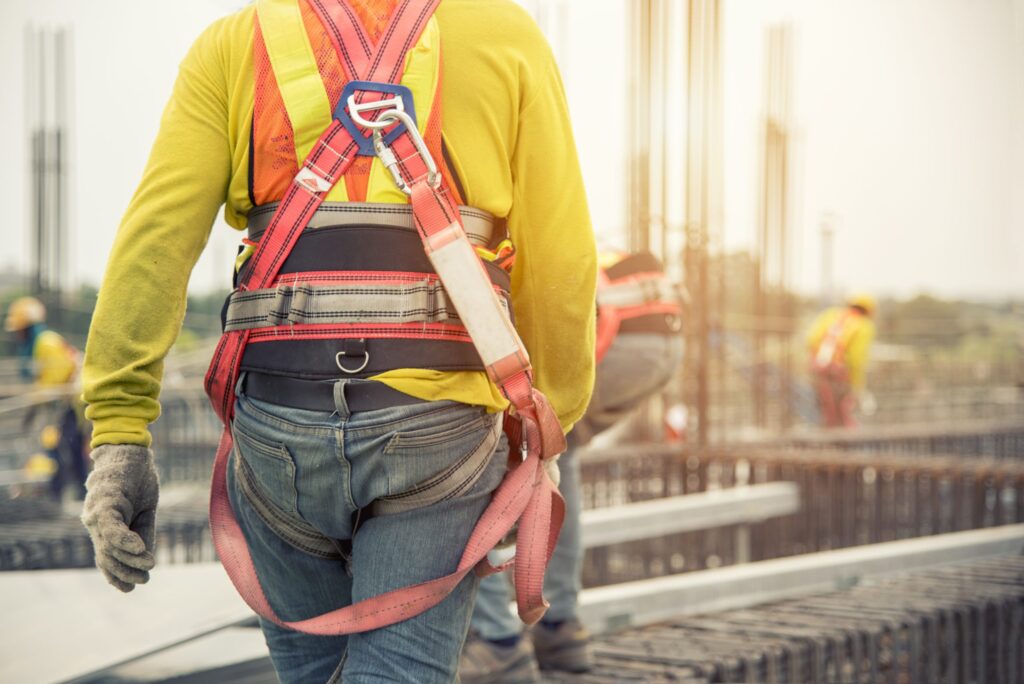Working At Height In Construction: Facts & Figures

Working at height is an integral part of the construction industry. Whether it’s building a multi-storey structure, repairing a roof, or installing a window, construction workers often find themselves working several feet above the ground. However, this routine aspect of their job comes with significant risks. Falls from height remain one of the leading causes of serious and fatal injuries in the construction industry.
At Tradesman Saver, we understand these risks and the importance of mitigating them with reliable contractors all risk insurance. This article delves into the facts and figures surrounding working at height in construction, offering insights into the risks involved, the safety measures that can be adopted, and the role of insurance in protecting businesses from the financial implications of accidents.
The Prevalence of Working at Height in the UK Construction Industry
In the UK, the construction industry is one of the largest sectors, employing over 2 million people. A significant proportion of these workers are routinely involved in tasks that require them to work at height. This could involve working on scaffolding, ladders, roof tops, or other elevated structures. The prevalence of such tasks makes the issue of safety when working at height a critical concern for the industry.
The Risks of Working at Height
Working at height can involve a wide range of activities, from working on a ladder or scaffold to working on a roof or other elevated structure. Each of these activities comes with its own set of risks. The most significant of these is the risk of falling, which can result in serious injury or even death. According to the Health and Safety Executive (HSE), falls from height are the most common cause of fatal injuries in the construction industry, accounting for nearly a third of all fatal injuries.
Understanding the Risks
Understanding the risks associated with working at height is the first step towards mitigating them. These risks can be influenced by a variety of factors, including the height at which the work is being carried out, the conditions of the work site, the type of equipment being used, and the nature of the task itself. For example, working on a steep roof in wet conditions presents a higher risk than working on a flat roof in dry conditions. Similarly, using a ladder for a task that requires a stable platform can increase the risk of a fall.
Safety Measures for Working at Height
When it comes to managing the risks associated with working at height, safety measures should follow a hierarchy of controls – avoid, prevent, arrest. This means that the first question to ask is – can the work be done safely from the ground? If not, the next step is to implement preventative measures to reduce the risk of a fall. If the risk cannot be eliminated entirely, measures should be put in place to arrest a fall should it occur.
Avoiding Work at Height
The best way to avoid the risks associated with working at height is to avoid working at height wherever possible. This could involve using extendable tools to carry out work from the ground, or using remote technology to inspect high structures. However, in many cases, working at height is unavoidable. In such cases, the focus should be on preventing falls.
Preventing Falls
Preventing falls involves implementing measures to stop a person from falling in the first place. This could involve the use of guardrails, safety nets, and personal fall protection systems. For example, when working on scaffolding, guardrails should be installed at all open sides to prevent workers from falling. Similarly, when working on a roof, safety nets can be installed below the work area to catch a person if they fall.
Arresting Falls
In situations where the risk of a fall cannot be eliminated, fall arrest systems should be used. These systems, which include safety harnesses and lifelines, are designed to stop a fall in progress and prevent the person from hitting the ground or a lower level. It’s important to note that fall arrest systems should only be used as a last resort when other measures are not feasible or do not provide sufficient protection.
Regular Safety Inspections and Maintenance
Regular safety inspections and maintenance of equipment are also crucial in ensuring safety when working at height. This includes regular checks of ladders, scaffolds, and other equipment to ensure they are in good condition and safe to use. Any equipment found to be damaged or defective should be taken out of service until it can be repaired or replaced.
The Importance of Training and Equipment
Proper training and the use of appropriate equipment are crucial in ensuring safety when working at height. This includes training on the correct use of ladders, scaffolds, and other equipment, as well as understanding the risks involved and how to mitigate them.
Training for Working at Height
Training is a key component of any safety strategy. Workers who are required to work at height should receive appropriate training on the risks involved and the measures they can take to mitigate these risks. This training should cover a range of topics, including the correct use of equipment, the importance of regular inspections, and the procedures to follow in the event of an emergency. Training should also be provided on a regular basis to ensure that workers’ knowledge and skills are up to date.
The Right Equipment for the Job
Using the right equipment is also crucial in ensuring safety when working at height. This includes not only the use of safety equipment such as harnesses and safety nets, but also the use of the right tools and equipment for the job. For example, using a ladder for a task that requires a stable platform can increase the risk of a fall. Similarly, using equipment that is not designed for the task at hand or that is in poor condition can also increase the risk of accidents.
The Role of Contractors All Risk Insurance
At Tradesman Saver, we offer contractors all risk insurance that provides coverage for property damage and third-party claims of injury or damage. This insurance is essential for any contractor or developer working at height, as it can protect your business from the financial implications of accidents and issues outside of your control.
What is Contractors All Risk Insurance?
Contractors’ all risk (CAR) insurance offers comprehensive coverage for property damage and third-party claims of injury or damage. These are the main risks associated with most construction projects, which is where you’re most likely to find contractors at work. A third-party claim can even come in from a subcontractor who you may not have previously worked with.
At Tradesman Saver, we understand the stress that comes with running your own business as a contractor, without the added hassle of ensuring you’re well protected in the event of any legal wranglings. If you do find yourself facing a claim from a third-party, you can rest easy knowing that you’re well covered with our insurance package, meaning you don’t have to worry about the financial costs.
Why Do You Need Contractors All Risk Insurance?
As a contractor, you will likely be working with specialist tools, in high-risk situations like construction sites. Our dedicated all risks insurance policy will cover any contract work, your own plant, tools and equipment, employee tools, hired-in plant, and temporary buildings erected during construction. The policy also includes a contract works insurance policy, which covers you financially for any repairs on site, or if you need to redo the work you were contracted to complete, due to causes like fire, flood, storms, vandalism, or theft.
Having the right insurance policy in place means you won’t have to pay out of your own pocket in the event of any accidents or issues outside of your control. Without this cover in place, you risk losing money on court cases, replacing damaged or stolen tools, or even having to entirely alter your work. Our contractors all risk insurance policy keeps you and your business safe throughout any contracted projects you’re working on.
Legal Requirements and Regulations:
In the UK, the Health and Safety Executive (HSE) provides guidelines and regulations for working at height. These regulations stipulate that all work at height must be properly planned, supervised, and carried out in a manner that is as safe as reasonably practicable.
The Work at Height Regulations 2005
The Work at Height Regulations 2005 is the key piece of legislation governing work at height in the UK. These regulations apply to all work at height where there is a risk of a fall that could cause personal injury. They place duties on employers, self-employed, and any person who controls the work of others to ensure that all work at height is planned, organised and carried out by competent persons.
Duty of Employers and Those in Control of Work at Height
Employers and those in control of any work at height activity must make sure work is properly planned, supervised and carried out by competent people. This includes using the right type of equipment for working at height. Employers must also assess the risk and take appropriate measures to address them, including providing appropriate training to workers.
The Impact of Accidents at Height:
Accidents at height can have severe consequences, not only for the workers involved but also for the business. These accidents can lead to costly legal proceedings, damage to reputation, and significant financial loss. Having the right insurance in place, such as our contractors all risk insurance, can provide a safety net for your business.
The Human Cost of Accidents at Height
The most immediate and devastating impact of accidents at height is the human cost. Falls from height can result in serious injuries, long-term disability, and even death. The physical and psychological impact on the injured worker and their family can be immense.
The Financial Cost of Accidents at Height
Accidents at height can also have a significant financial impact on businesses. This can include the direct costs of an accident, such as medical expenses and compensation payments, as well as indirect costs such as lost productivity, increased insurance premiums, and damage to the company’s reputation.
Looking For Insurance You Can Rely On? Make Sure It’s Tradesman Saver
Working at height in construction comes with significant risks, but with the right safety measures, training, and insurance in place, these risks can be managed effectively. At Tradesman Saver, we’re committed to helping you protect your business and your workers. Contact us today to learn more about our contractors all risk insurance and how it can benefit your business.
Remember, safety should always be the top priority when working at height. Stay informed, stay prepared, and stay insured with Tradesman Saver.






